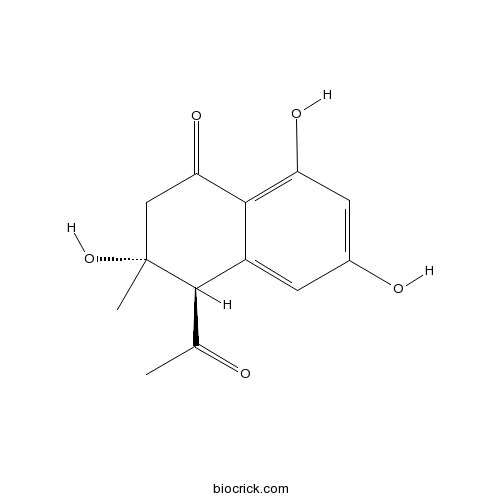4-(trans)-Acetyl-3,6,8-trihydroxy-3-methyldihydronaphthalenoneCAS# 263368-91-8 |

- 4-(cis)-Acetyl-3,6,8-trihydroxy-3-methyldihydronaphthalenone
Catalog No.:BCN1468
CAS No.:263368-92-9
Quality Control & MSDS
3D structure
Package In Stock
Number of papers citing our products

| Cas No. | 263368-91-8 | SDF | Download SDF |
| PubChem ID | 10753168 | Appearance | Powder |
| Formula | C13H14O5 | M.Wt | 250.25 |
| Type of Compound | Phenols | Storage | Desiccate at -20°C |
| Solubility | Soluble in Chloroform,Dichloromethane,Ethyl Acetate,DMSO,Acetone,etc. | ||
| Chemical Name | (3R,4R)-4-acetyl-3,6,8-trihydroxy-3-methyl-2,4-dihydronaphthalen-1-one | ||
| SMILES | CC(=O)C1C2=CC(=CC(=C2C(=O)CC1(C)O)O)O | ||
| Standard InChIKey | QDNOAZOXGLUUEB-CHWSQXEVSA-N | ||
| Standard InChI | InChI=1S/C13H14O5/c1-6(14)12-8-3-7(15)4-9(16)11(8)10(17)5-13(12,2)18/h3-4,12,15-16,18H,5H2,1-2H3/t12-,13-/m1/s1 | ||
| General tips | For obtaining a higher solubility , please warm the tube at 37 ℃ and shake it in the ultrasonic bath for a while.Stock solution can be stored below -20℃ for several months. We recommend that you prepare and use the solution on the same day. However, if the test schedule requires, the stock solutions can be prepared in advance, and the stock solution must be sealed and stored below -20℃. In general, the stock solution can be kept for several months. Before use, we recommend that you leave the vial at room temperature for at least an hour before opening it. |
||
| About Packaging | 1. The packaging of the product may be reversed during transportation, cause the high purity compounds to adhere to the neck or cap of the vial.Take the vail out of its packaging and shake gently until the compounds fall to the bottom of the vial. 2. For liquid products, please centrifuge at 500xg to gather the liquid to the bottom of the vial. 3. Try to avoid loss or contamination during the experiment. |
||
| Shipping Condition | Packaging according to customer requirements(5mg, 10mg, 20mg and more). Ship via FedEx, DHL, UPS, EMS or other couriers with RT, or blue ice upon request. | ||
| Description | 4-(trans)-Acetyl-3,6,8-trihydroxy-3-methyldihydronaphthalenone is a natural product from Caesalpinia minax. |
| Structure Identification | Zhongguo Zhong Yao Za Zhi. 2013 Apr;38(7):1014-7.Phenolic compounds from Caesalpinia minax.[Pubmed: 23847948]
|

4-(trans)-Acetyl-3,6,8-trihydroxy-3-methyldihydronaphthalenone Dilution Calculator

4-(trans)-Acetyl-3,6,8-trihydroxy-3-methyldihydronaphthalenone Molarity Calculator
| 1 mg | 5 mg | 10 mg | 20 mg | 25 mg | |
| 1 mM | 3.996 mL | 19.98 mL | 39.96 mL | 79.9201 mL | 99.9001 mL |
| 5 mM | 0.7992 mL | 3.996 mL | 7.992 mL | 15.984 mL | 19.98 mL |
| 10 mM | 0.3996 mL | 1.998 mL | 3.996 mL | 7.992 mL | 9.99 mL |
| 50 mM | 0.0799 mL | 0.3996 mL | 0.7992 mL | 1.5984 mL | 1.998 mL |
| 100 mM | 0.04 mL | 0.1998 mL | 0.3996 mL | 0.7992 mL | 0.999 mL |
| * Note: If you are in the process of experiment, it's necessary to make the dilution ratios of the samples. The dilution data above is only for reference. Normally, it's can get a better solubility within lower of Concentrations. | |||||

Calcutta University

University of Minnesota

University of Maryland School of Medicine

University of Illinois at Chicago

The Ohio State University

University of Zurich

Harvard University

Colorado State University

Auburn University

Yale University

Worcester Polytechnic Institute

Washington State University

Stanford University

University of Leipzig

Universidade da Beira Interior

The Institute of Cancer Research

Heidelberg University

University of Amsterdam

University of Auckland

TsingHua University

The University of Michigan

Miami University

DRURY University

Jilin University

Fudan University

Wuhan University

Sun Yat-sen University

Universite de Paris

Deemed University

Auckland University

The University of Tokyo

Korea University
- (S)-(-)-Pindolol
Catalog No.:BCC6916
CAS No.:26328-11-0
- Perilloxin
Catalog No.:BCN6614
CAS No.:263249-77-0
- Dehydroperilloxin
Catalog No.:BCN7506
CAS No.:263241-09-4
- 22-Dehydroclerosterol
Catalog No.:BCN5141
CAS No.:26315-07-1
- Pepstatin A
Catalog No.:BCC1218
CAS No.:26305-03-3
- Physcion-8-O-beta-D-monoglucoside
Catalog No.:BCN8511
CAS No.:26296-54-8
- Ficaprenol 11
Catalog No.:BCN5140
CAS No.:26296-50-4
- 2,3',4,6-Tetrahydroxybenzophenone
Catalog No.:BCN5139
CAS No.:26271-33-0
- AICAR
Catalog No.:BCC3606
CAS No.:2627-69-2
- Peritassine A
Catalog No.:BCC9117
CAS No.:262601-67-2
- Boc-β-Homo-Pro-OH
Catalog No.:BCC2628
CAS No.:26250-84-0
- BVD 10
Catalog No.:BCC5882
CAS No.:262418-00-8
- 4-(cis)-Acetyl-3,6,8-trihydroxy-3-methyldihydronaphthalenone
Catalog No.:BCN1468
CAS No.:263368-92-9
- Escin IB
Catalog No.:BCN2970
CAS No.:26339-90-2
- Aesculuside B
Catalog No.:BCC8115
CAS No.:26339-92-4
- 1,2-Benzisothiazolin-3-one
Catalog No.:BCC8412
CAS No.:2634-33-5
- H-Arg-OMe.2HCl
Catalog No.:BCC2861
CAS No.:26340-89-6
- Rhodojaponin III
Catalog No.:BCN2809
CAS No.:26342-66-5
- H-Lys-OMe .2HCl
Catalog No.:BCC2981
CAS No.:26348-70-9
- Stachysterone D
Catalog No.:BCC8362
CAS No.:26361-67-1
- ESI-09
Catalog No.:BCC5504
CAS No.:263707-16-0
- PPT
Catalog No.:BCC7062
CAS No.:263717-53-9
- EMDT oxalate
Catalog No.:BCC7888
CAS No.:263744-72-5
- Buergerinin G
Catalog No.:BCN4659
CAS No.:263764-83-6
[Phenolic compounds from Caesalpinia minax].[Pubmed:23847948]
Zhongguo Zhong Yao Za Zhi. 2013 Apr;38(7):1014-7.
Fifteen compounds were obtained from the twigs and leaves of Caesalpinia minax. Their structures were identified as apigenin (1), 5,7,3',4'- tetrahydroxy-3-methoxyflavone (2), luteolin-5, 3 '-dimethyl-ether (3), thevetiaflavon (4), apigenin-7-O-beta-D-glucuronide (5), bonducellin (6), 7-hydroxy-3-( 4-hydroxybenzylidene )-chroman-4-one (7), 3-deoxysappanchalcone (8), 5-acetonyl-7-hydroxy-2-methyl chromone (9), 4-(trans)-acetyl-3,6,8-trihydroxy-3-methyl-dihydronaphthalenone (10), 4-(cis)-acetyl-3,6,8-trihydroxy-3-methyl-dihydronaphthalenone (11), vanillic acid (12), omega-hydroxypropioquaiacone (13), syringaresinol (14) and uracil (15). All compounds were isolated from C. minax for the first time. Compounds 1-14 were phenolic compounds and compounds 1-5, 9-13 and 15 were isolated from the genus Caesalpinia for the first time.


